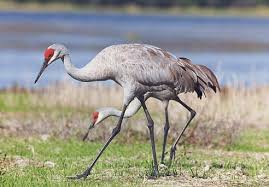 (Editor’s note: According to the Iowa Department of Natural Resources, with 2011 the most recent year for which information is available, sandhill cranes have been spotted in Boone and Guthrie counties, but not Greene County.)
(Editor’s note: According to the Iowa Department of Natural Resources, with 2011 the most recent year for which information is available, sandhill cranes have been spotted in Boone and Guthrie counties, but not Greene County.)
Seeing is believing.
Add Johnson County to the areas in Iowa with uncommon reports of sandhill crane reproduction. An adult pair has seen regularly on a wetland near Solon. A couple times this spring and summer, drivers braked to avoid windshield roadkill, to allow the lean, reddish brown bird right of way, across the two-lane highway.
About that time passersby witnessed a ‘courtship dance;’ indicating these four foot tall birds were intent on sticking around. Now, a darker brown colt, feeding with them, seals the deal.
Actually, a pair with a couple young was spotted in 2014 by DNR wildlife workers upstream on the Iowa River corridor. That family, on the Hawkeye Wildlife Area, was the first confirmed sighting of nesting sandhills, in the county. This year’s sighting doubles the population, spreading to another corner of Johnson County.
Fossils of sandhill cranes date back 2.5 million years. These days, they thrive on marshes and wet prairies. Their diet is just about anything they can swallow; small rodents, frogs, insects, young birds, eggs, seed, grass shoots, grain, bulbs…aquatic plants, too.
Like many water-oriented species, however, cranes disappeared in the 19th century as Europeans settled Iowa. Unregulated hunting and loss of wetlands, as marshes were drained for farmable acres, led to rapid declines.
Through the 1900s, you were lucky if you spotted a couple migrating in the spring. By the 1970s and ‘80s, though, numbers increased markedly. In 1992, the first successful nest was confirmed in Otter Creek Wildlife Area in Tama County. Within a couple years, other state-managed wildlife areas had their own crane spotting. By 2006, the confirmed nesting population was at 170…with most around Otter Creek, Sweet Marsh (Bremer County) and the Green Island Bottoms (Jackson County). Since ’92, reproduction has been reported in 21 Iowa counties.
The best bet for viewing these still uncommon Iowa cranes? Watch from a distance, preferably a blind; even if it is just your vehicle along the roadside. Pack along binoculars or a spotting scope to get up close.
A side note? These most often (exceptions in far western Iowa) are not the same populations that create clouds of migrating mayhem in central Nebraska. Those are Arctic nesting cranes. In Iowa, cranes are more likely moving through Wisconsin to nest, or to go further north. Iowa birds more likely winter in Georgia and Florida. ~Iowa Department of Natural Resources / Conservation and recreation division
